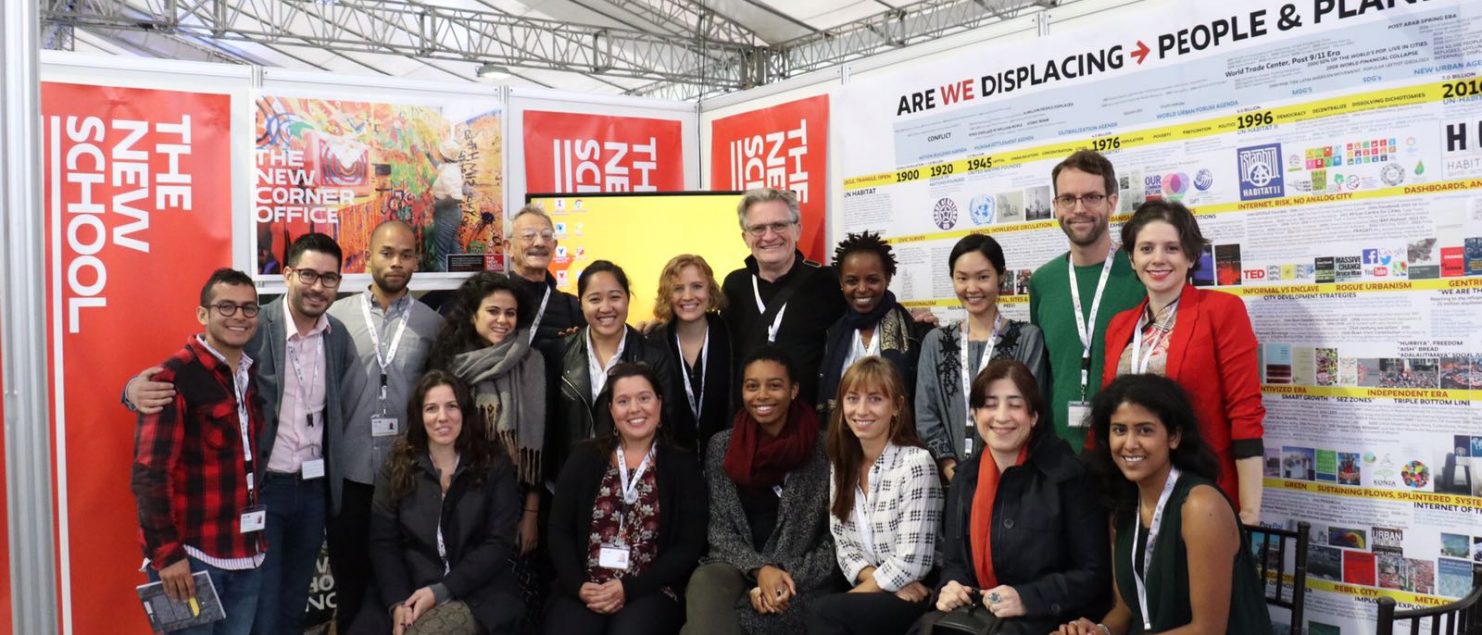Global Urban Futures Calls for a ‘New Urban Practice to Achieve a New Urban Agenda’ at Habitat 3
As United Nations member states signed onto the New Urban Agenda — a series of commitments to improve urban well-being — at the Habitat III conference in Quito, Ecuador last week, a delegation of New School students and faculty asked a bold, but necessary question.
How can certain countries make new commitments when they haven’t lived up to the old ones?
UN member states had tried this before: 20 years ago at Habitat II in Istanbul, Turkey, they made similar promises — then, as part of an agreement known as the Habitat Agenda — to address problems in cities.
However, after tireless research, New School students and faculty members found that more than half the countries that made commitments to the Habitat Agenda are not living up to them. The delegation shared this discovery, both at a New School-branded booth and in more than a dozen panels, with as many of the 53,000 attendees of Habitat III as they could.
For some conference-goers, particularly leaders from the member states in question, the news from the HCI was hard to stomach. But for the New School delegation, getting to the truth about the marginal progress made on the Habitat Agenda was the first step to achieving real progress on the New Urban Agenda.
“Some people have said that we’re in the business of shame,” says David López García, PhD Public and Urban Policy ‘19, a student member of The New School delegation. “But no, we’re in the business of finding out ways to improve country performance on the Habitat Agenda, and hence, the lives of billions of city dwellers.”
The research is laid out in the Habitat Commitment Index (HCI), an initiative of Global Urban Futures (GUF), a project supported by the Ford Foundation and the Julien Studley Faculty Research Fund. Coordinated by Lena Simet, Public and Urban Policy ’18, the HCI measures the progress of 169 countries on 15 indicators — infrastructure, poverty, employment, sustainability, institutional capacity, and gender — related to the Habitat Agenda. The assessment, which is the basis of GUF’s Human Commitment Project (HCP), debunks the unfounded assertion in the New Urban Agenda that prior commitments were met and that substantial headway had been made on its predecessor agreement. At the same time, it calls for a new approach — what GUF calls “a New Urban Practice to Achieve a New Urban Agenda.”
The HCP — which includes a book, “Habitat en Deuda: Veinte anos de politicas urbanas en America Latina,” a qualitative assessment of the experiences of six Latin American countries from 1996 to 2016 — is a reflection of The New School’s robust connection to the global community and its commitment to tackling real-world issues.
“It is hoped that this project will contribute to the New Urban Agenda by clearly suggesting to national and city governments, international organizations, and civil society that the nature of commitments matter,” says Michael Cohen, Professor of International Affairs, who guided the HCP. “Formulating ambitious and realistic commitments is an indispensable first step towards achieving real progress in improving the lives of billions of city residents around the world.”
At Habitat III, GUF’s message was loud and clear: any new commitments must reflect knowledge about the degree of fulfillment of commitments made by governments at Habitat II. Commitments should not only be about the “what,” the report states, but also the “how.” In other words, how can countries and cities, through their national and urban governments, undertake a more focused and successful effort in reaching new urban goals?
One piece of advice in the HCP stands out: what GUF calls “a New Urban Practice to Achieve a New Urban Agenda.” That watchword points to a more integrated approach that transcends jurisdictional and administrative boundaries, as well as bottom-up solutions emerging from local ecologies, economies, cultures, and institutions.
The assessments also suggests that, despite conventional wisdom on the subject, “economic growth did not automatically lead to the fulfillment of urban goals,” Simet says.
“This suggests that there are non-economic factors driving urban performance,” she adds. “Future research should therefore focus on the kinds of institutions, policies, and practices that could better translate progress into urban well-being.”
While the HCP gave GUF students the chance to positively impact the world, it also provided an opportunity to engage in a unique educational experience. Students were challenged to flesh out the meaning behind the (sometimes opaque) Habitat Agenda commitments, determine which data sets to use, and finally, come up with the indicators to measure country performance.
“From the beginning, Michael Cohen’s intention was to make the project student led, so it could be learning process in it of itself,” López García says. “Working collaboratively as part of a team, making the index, presenting our findings — it was all part of the educational experience.”
Whether or not world leaders are open to being educated themselves remains to be seen. López García and his peers in GUF were encouraged by the reaction to the HCP. During the final two days of the conference, dozens of attendees visited The New School-branded booth, asking for copies of the report and offering feedback. Even a few government leaders inquired about it.
At the very least, López García says, GUF “started a conversation” — one that may very well lead to actionable solutions to some of the most pressing problems facing the world’s cities.
